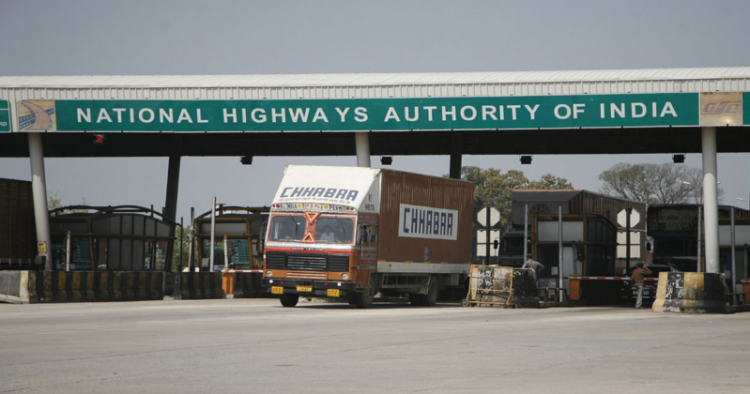.The National Highways Authority of India (NHAI)is inviting global companies to show their interest in helping out to improve toll collection on National Highways. They want to use international know-how and expertise to set up a new electronic toll collection system based on Global Navigation Satellite System (GNSS) technology. This new system will get rid of physical toll booths, thereby addressing several inefficiencies and bottlenecks caused by manual toll collection.
The initiative is spearheaded by the Indian Highways Management Company Limited (IHMCL), a specialized entity that focuses on modernizing and managing India’s highway infrastructure. They are switching to a new GNSS-based toll system to make toll collection more efficient and clear. This new technology will make traveling on highways easier, with less traffic and shorter wait times at toll booths, resulting in a smoother and faster trip.
NHAI intends to integrate the GNSS-based electronic toll collection (ETC) system within the existing FASTag ecosystem, initially adopting a hybrid model alongside Radio Frequency Indentification i.e. RFID-based ETC. This integration aims to build on the current FASTag system, which uses RFID technology for toll collection, by introducing the more advanced GNSS technology. This will make the switch smoother and less disruptive for users. It also allows for thorough testing and adjustments to ensure the new GPS system works well with the current RFID system before fully switching over.
Dedicated Global Navigation Satellite System (GNSS) lanes will be established at toll plazas to make it easier for vehicles using this technology to pass through. These lanes will be specifically designed to handle vehicles that have Global Navigation Satellite System (GNSS) technology, so they can move through the toll plazas without stopping. The dedicated lanes will help in managing the traffic more efficiently by separating vehicles using different toll collection systems, which will reduce congestion and waiting times. Adding these special lanes is important to show how useful GNSS technology is, making it more appealing for people to use on highways.
With this system, vehicles can pass through toll points without having to stop, which will cut down on traffic and save travel time. It also makes paying tolls easier and quicker, improving the overall driving experience. A great feature of this system is that it charges drivers based on the exact distance they travel on the highway. This means fairer pricing and could make shorter trips cheaper.
Additionally, the GNSS-based system will make toll collection more efficient by using advanced technology. This will reduce the need for manual work and decrease the chances of mistakes and corruption. By preventing revenue loss and stopping toll evasion, it will ensure that all toll money is correctly collected and recorded. This will provide a steady flow of funds for highway maintenance and development.
Getting rid of physical toll booths will help reduce traffic jams at toll plazas, allowing cars to move more smoothly. This will save drivers time and use less fuel, which will also cut down on pollution. Without having to stop and start at toll booths, traffic will flow more steadily and efficiently. This means less fuel is wasted and fewer emissions are produced, which is better for the environment. Overall, smoother traffic will make driving more enjoyable and contribute to a cleaner, greener planet by reducing pollution.
By using a system based on the Global Navigation Satellite System, there will be less need for people to manage toll collection manually, which will also lower the chances of people avoiding tolls. This system will make toll collection more efficient, bringing in more money. The extra money can be used to maintain and expand highways, which helps with sustainable development. Automated toll collection also reduces mistakes and cheating, making sure that toll money is collected accurately. With more reliable income, the National Highways Authority of India can better fund the maintenance and growth of India’s highway network. These improvements support economic growth and development, ensuring the transportation infrastructure can meet the country’s increasing needs.
Efficient transportation is essential for economic growth. The new toll system will make travel quicker and easier, helping both goods and people move faster. This will improve trade and business, especially for industries that depend on road transport. Better highways mean quicker deliveries and lower transportation costs, which will help Indian businesses compete better. Additionally, improved connectivity will make remote areas more accessible, supporting balanced economic growth throughout the country.
The GNSS-based system will make toll collection more transparent, which helps reduce corruption and fraud. This supports Prime Minister Modi’s goal of promoting digital governance and accountability in public services. By using technology, toll collection becomes clearer and harder to manipulate. This lowers the chances for corruption and makes sure the money collected is used properly. Moving towards digital governance shows a commitment to creating a more trustworthy and efficient public administration, increasing public confidence in government efforts.
Using distance-based tolling means people pay for how far they travel on roads. This makes sure everyone pays a fair amount based on how much they use the roads, making things fairer for everyone who drives. It also helps cut down on unnecessary trips, making the roads work better. Plus, it makes costs easier to understand and fairer for travelers, which makes them happier with the toll system. Overall, it encourages people to use roads more wisely and sustainably. The new toll collection system in India uses satellites to track vehicles and charge tolls electronically. It’s a big plan that will make things work better, fairer, and easier for everyone who uses the roads. It’s part of Prime Minister Modi’s vision to make India more modern and prosperous.



















Comments